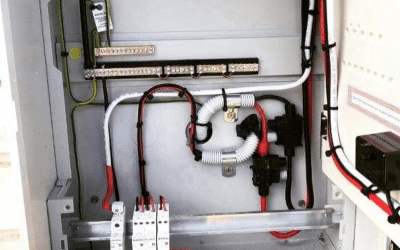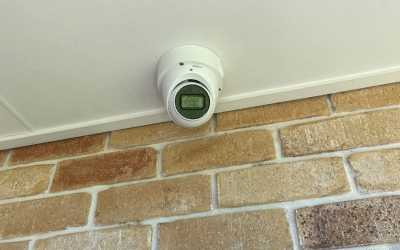Behind the walls and beneath the floors of our homes, there are unsung heroes that power our lives and keep us connected. These hidden heroes are the essential components of our home’s electrical system.
Without a doubt, a dependable electrical system is crucial for the smooth functioning of our daily routines and the overall safety and comfort of our homes. From powering our appliances and lighting up our spaces to keeping us connected to the digital world, the electrical system plays a vital role in our modern lives.
In this article, we will explore the intricacies of your home’s electrical system, shedding light on its essential components that often go unnoticed. By understanding your house electrical components, you can gain a deeper insight into how electricity flows through your home, enabling you to make informed decisions about maintenance, upgrades, and even energy efficiency.
So, let’s embark on a journey behind the scenes, discovering the hidden heroes that make up the backbone of your home’s electrical system. From the electrical panel that serves as the power source to the intricate wiring that acts as the circulatory system, and from the safety devices that protect you from electrical hazards to the nerve center of switchboards, we will uncover the secrets of each component and its significance.
By the end of this article, you will have a comprehensive understanding of the essential components that make up your home’s electrical system. Armed with this knowledge, you can ensure the smooth and safe operation of your electrical system, giving you peace of mind and empowering you to make informed decisions about your home’s electrical infrastructure.
So, let’s dive in and unravel the mysteries of the hidden heroes that keep the lights on and the devices humming in your Brisbane home.
The Power Source: Electrical Panel
The electrical panel, also known as the breaker box or distribution board, serves as the power source and control center of your home’s electrical system. Understanding its role and components is crucial for every Brisbane resident looking to gain insight into their electrical infrastructure.
Understanding the Electrical Panel
The electrical panel is a metal box that houses a collection of switches, fuses, and circuit breakers. It acts as a central hub where electricity enters your home from the utility grid and is distributed to different circuits throughout the house. It is typically located in a utility room, basement, or garage.
By opening the panel’s cover, you can access the inner workings and observe the various components that make it function. However, it’s important to note that working on the electrical panel should only be done by a qualified electrician due to the risks involved.
Main Breaker: Gateway to Power
The main breaker, also known as the service disconnect switch, is a prominent component within the electrical panel. It acts as the gateway to power, allowing you to control the flow of electricity into your home. In case of emergencies or maintenance, the main breaker can be switched off to cut off power supply to the entire house.
The main breaker is usually a large switch located at the top or bottom of the panel, with its ampere rating clearly labeled. It serves as a safety device, protecting your home’s electrical system from overloads and short circuits. If the electrical load exceeds the capacity of the main breaker, it will trip, cutting off power to prevent damage and hazards.
Circuit Breakers: Individual Power Control
Within the electrical panel, you will find a series of smaller switches called circuit breakers. These breakers are designed to control the flow of electricity to individual circuits throughout your home. Each circuit breaker is dedicated to a specific area or set of electrical outlets, ensuring that in the event of a fault or overload, only the affected circuit is shut off while the rest of your home remains powered.
Circuit breakers are typically labeled to indicate which areas or appliances they control. This labeling allows for easy identification and troubleshooting in case of
Just as our bodies rely on a complex network of blood vessels to deliver oxygen and nutrients, your home’s electrical system relies on wiring to carry electricity to different areas and devices. Understanding the basics of wiring and the components associated with it is crucial for Brisbane residents seeking to grasp the inner workings of their electrical systems.
Wiring: The Circulatory System
Just as our bodies rely on a complex network of blood vessels to deliver oxygen and nutrients, your home’s electrical system relies on wiring to carry electricity to different areas and devices. Understanding the basics of wiring and the components associated with it is crucial for Brisbane residents seeking to grasp the inner workings of their electrical systems.
Wiring Basics: Conducting Electricity
Wiring is the intricate network of electrical conductors that runs through your home, allowing electricity to flow from the electrical panel to various outlets, switches, and appliances. It consists of copper or aluminum wires insulated with materials such as plastic or rubber to prevent electrical shocks and short circuits.
Types of Electrical Wiring
There are different types of electrical wiring commonly used in residential settings. Some of the most prevalent types include:
Non-Metallic Sheathed Cable (NM): This is a versatile type of wiring commonly referred to as Romex. It consists of two or more insulated conductors, along with a bare or insulated grounding wire, all encased in a non-metallic sheath.
Armored Cable (AC): Also known as BX cable, armored cable features a flexible metal sheath that provides protection to the insulated conductors within. It is often used in areas where extra durability and mechanical protection are required.
Underground Feeder (UF) Cable: This type of wiring is specifically designed for underground installations. It is moisture-resistant and can withstand exposure to direct burial.
Understanding the different types of electrical wiring in your home can be helpful when it comes to renovations, repairs, or adding new electrical connections.
Outlets and Switches: Connecting Devices
Outlets and switches are the components that allow you to connect and control electrical devices throughout your home. Outlets, also known as receptacles, provide access to electrical power for plugging in appliances, lamps, and other devices. Switches, on the other hand, control the flow of electricity to lighting fixtures, ceiling fans, and other electrical loads.
Types of Outlets and Switches
There are various types of outlets and switches commonly found in residential settings. These include:
Duplex Outlets: These are the most common type of outlets, featuring two receptacles that can accommodate standard two-prong or three-prong plugs.
GFCI Outlets: Ground Fault Circuit Interrupter (GFCI) outlets are equipped with built-in protection against electrical shocks. They are typically installed in areas prone to moisture, such as bathrooms, kitchens, and outdoor locations.
Dimmer Switches: Dimmer switches provide the ability to adjust the brightness of lights, allowing you to create different lighting moods and save energy.
Smart Switches and Outlets: These modern devices can be controlled remotely using smartphones or voice commands, providing convenience and energy management capabilities.
GFCIs and AFCIs: Safety Measures
GFCI outlets, as mentioned earlier, play a crucial role in electrical safety by quickly shutting off power in the event of a ground fault, reducing the risk of electrical shocks. Another important safety measure is the Arc Fault Circuit Interrupter (AFCI), which detects dangerous electrical arcs and shuts off power to prevent electrical fires.
GFCIs and AFCIs are typically installed in areas where electrical hazards are more prevalent, such as kitchens, bathrooms, bedrooms, and living rooms.
By understanding the basics of wiring, outlets, and switches, as well as the importance of safety measures like GFCIs and AFCIs, Brisbane residents can ensure the efficient and secure operation of their home’s electrical system. These components form the backbone of electrical connectivity and control, allowing us to enjoy the modern comforts and conveniences electricity provides.
Light Up: Illumination Components
When it comes to creating a welcoming and functional atmosphere in your Brisbane home, lighting plays a pivotal role. Understanding the various components involved in illuminating your space can help you make informed decisions about the right lighting choices for each area. Let’s shed some light on these essential illumination components.
Light Fixtures: Brightening Your Space
Light fixtures are the visible elements that house the light source and distribute illumination throughout your home. They come in a wide array of styles, shapes, and sizes, allowing you to enhance the aesthetic appeal of your space while fulfilling functional lighting needs.
Types of Light Fixtures
There is a diverse range of light fixtures available to suit different preferences and purposes. Some common types include:
Chandeliers: Elegant and statement-making, chandeliers often serve as a centerpiece in dining rooms, foyers, or grand living spaces, providing ambient lighting and a touch of luxury.
Pendant Lights: Hanging from the ceiling by a cord or chain, pendant lights are versatile and can be used to illuminate specific areas such as kitchen islands, dining tables, or entryways.
Ceiling Fixtures: Recessed lights, flush-mount fixtures, or semi-flush mount fixtures are installed directly into the ceiling, offering general illumination in various rooms throughout the house.
Wall Sconces: Mounted on walls, wall sconces provide accent lighting and add a decorative element to hallways, bathrooms, or bedrooms.
Track Lighting: Consisting of a track with adjustable fixtures, track lighting is often used to highlight artwork, architectural features, or task areas such as home offices or kitchen workspaces.
Bulbs and Lamps: Shining Light
While light fixtures provide the housing for the light source, bulbs and lamps are the actual sources of illumination that brighten up your space. They come in different types, each offering unique characteristics and benefits.
Incandescent, Fluorescent, LED, and Halogen Bulbs
Incandescent Bulbs: Traditional incandescent bulbs produce light by heating a filament. Although they are being phased out due to their energy inefficiency, they still provide warm and familiar lighting.
Fluorescent Bulbs: Fluorescent bulbs use a chemical reaction to produce light and are more energy-efficient than incandescent bulbs. They are commonly found in offices, kitchens, and garages.
LED Bulbs: Light Emitting Diode (LED) bulbs are highly energy-efficient, long-lasting, and versatile. They come in a variety of colors and can be dimmable, making them suitable for a wide range of lighting applications.
Halogen Bulbs: Halogen bulbs provide bright, white light and are often used in recessed fixtures, track lighting, or outdoor security lighting. They offer excellent color rendering and precise beam control.
Specialty Lamps: Dimmers and Smart Bulbs
In addition to standard bulbs, there are specialty lamps that offer unique functionalities. Dimmer switches allow you to adjust the brightness of the lighting, creating ambiance and saving energy. Smart bulbs, on the other hand, can be controlled remotely using smartphone apps or voice commands, providing convenience and advanced lighting control options.
Understanding the different types of light fixtures, bulbs, and lamps empowers Brisbane residents to create the perfect lighting scheme for their homes. By selecting the right combination, you can enhance the visual appeal, functionality, and energy efficiency of each room, creating an inviting and well-lit space for all your daily activities.
Safety First: Protective Devices
When it comes to your home’s electrical system, safety should always be a top priority. Fortunately, there are essential protective devices designed to safeguard both your property and your well-being. Let’s explore these hidden heroes that provide an extra layer of protection in your Brisbane home.
Grounding Systems: Protecting Against Electrical Shocks
Grounding systems are critical safety features in your home’s electrical system. They provide a path for electrical currents to safely dissipate into the ground, preventing the risk of electric shocks. The grounding system consists of grounding wires, grounding electrodes (such as grounding rods), and a connection to the main electrical panel.
By properly grounding your electrical system, any potential electrical faults or excess current can be safely redirected, protecting you and your loved ones from dangerous shocks. It is essential to ensure that your home’s electrical system is adequately grounded, and regular inspections by a licensed electrician can help maintain the integrity of this protective measure.
Surge Protectors: Shielding from Power Surges
Power surges, caused by sudden increases in electrical voltage, can be detrimental to your electrical devices and appliances. Surge protectors act as guardians, shielding your valuable electronics from the harmful effects of power surges.
Types of Surge Protectors
There are various types of surge protectors available, offering different levels of protection:
Power Strips with Surge Protection: These surge protectors are commonly used to plug in multiple devices simultaneously. They offer basic protection against power surges, making them suitable for everyday use.
Whole-House Surge Protectors: Installed at the electrical panel, these surge protectors provide comprehensive protection for your entire home. They safeguard not only individual devices but also your home’s electrical system itself.
Point-of-Use Surge Protectors: These surge protectors are designed to be installed directly at specific outlets or electrical equipment, offering targeted protection against power surges for critical devices.
By utilizing surge protectors throughout your home, you can minimize the risk of damage to your electronic equipment caused by power surges and enjoy greater peace of mind.
Arc Fault Circuit Interrupters (AFCIs): Preventing Fires
Electrical fires are a serious concern for homeowners. Arc Fault Circuit Interrupters (AFCIs) are advanced safety devices that detect and mitigate the risk of electrical fires caused by arc faults, which occur when electricity jumps across damaged or deteriorating wires.
AFCIs continuously monitor electrical circuits for dangerous arc faults and immediately interrupt the flow of electricity to prevent fire hazards. They are typically installed in areas such as bedrooms, living rooms, and other spaces where fires can potentially start from electrical faults.
AFCI Installation and Benefits
Installing AFCIs in your home is a proactive step towards fire prevention. A licensed electrician can assess your electrical system and determine the appropriate locations for AFCI installation. By having AFCIs in place, you significantly reduce the risk of electrical fires, providing a safer living environment for you and your family.
The combination of proper grounding systems, surge protectors, and AFCIs forms a robust safety net for your home’s electrical system. These protective devices offer peace of mind, ensuring that your electrical infrastructure is equipped to handle unforeseen circumstances and safeguarding your property and loved ones from potential electrical hazards.
The Nerve Center: Electrical Switchboards
Behind the scenes of your home’s electrical system, the electrical switchboard acts as the nerve center, coordinating and managing the flow of power throughout your property. Let’s delve into the essential components of the electrical switchboard and understand their significance in keeping your Brisbane home powered and safe.
Distribution Boards: Organizing Power
Distribution boards, also known as breaker panels or fuse boxes, are the central units within the electrical switchboard. They house the circuit breakers or fuses that control and distribute electricity to different areas and circuits in your home.
Distribution boards play a crucial role in organizing and dividing electrical power efficiently. Each circuit breaker or fuse is dedicated to a specific area or set of electrical outlets, ensuring that in the event of an overload or fault, only the affected circuit is interrupted, while the rest of your home remains powered.
RCDs: Life-Saving Devices
Residual Current Devices (RCDs), also known as safety switches, are life-saving devices designed to detect and quickly respond to electrical faults that could result in electric shocks. RCDs continuously monitor the electrical current flowing through circuits and can detect even the smallest imbalance, providing an additional layer of protection.
When an imbalance is detected, indicating a potential fault, the RCD trips and cuts off the power to the circuit almost instantly, preventing electric shocks and reducing the risk of electrical accidents. RCDs are typically installed in areas with a higher risk of electrical shock, such as bathrooms, kitchens, and outdoor power outlets.
Meter Boxes: Monitoring Energy Consumption
Meter boxes are an integral part of the electrical switchboard, housing the electricity meter that measures your home’s energy consumption. The meter box provides important information about the amount of electricity you are using, allowing you to monitor and manage your energy consumption effectively.
Meter boxes are typically located outside the home, near the point where the main electrical supply enters your property. They provide access to electricity providers for meter reading, billing, and maintenance purposes.
Safety Switches: Quick Power Cutoff
Safety switches, similar to RCDs, provide an additional level of protection against electric shocks and electrical faults. They are designed to quickly cut off the power supply to a circuit in the event of a fault, reducing the risk of electrical accidents.
Unlike circuit breakers that primarily protect against overloads and short circuits, safety switches are focused on protecting against electrical shocks caused by faults in appliances, faulty wiring, or accidental contact with live wires. Safety switches are typically installed at the electrical switchboard and can be manually reset after a trip.
Understanding the role of the electrical switchboard, distribution boards, RCDs, meter boxes, and safety switches is vital for maintaining a safe and efficient electrical system in your Brisbane home. These components work together to ensure the proper distribution of electricity, protect against electrical faults and shocks, and provide valuable information about your energy consumption.
The Backbone: Electrical Cables
While the components we’ve explored so far play crucial roles in your home’s electrical system, it is the electrical cables that serve as the backbone, carrying electrical currents and connecting the various components together. Let’s delve into the world of electrical cables and discover their importance in keeping your Brisbane home powered and running smoothly.
Cable Types: Connecting the Dots
Electrical cables are responsible for carrying electricity from the electrical panel to outlets, switches, appliances, and other electrical devices throughout your home. There are different types of electrical cables, each designed for specific purposes and applications.
Common types of electrical cables include:
Non-Metallic Sheathed Cable (NM): Also known as Romex, NM cable is widely used in residential settings. It consists of two or more insulated conductors and a bare or insulated grounding wire, all enclosed in a non-metallic sheath. NM cable is suitable for general-purpose wiring.
Armored Cable (AC): Armored cable, often referred to as BX cable, features a flexible metal sheath that provides protection to the insulated conductors within. AC cable is commonly used in areas where additional mechanical protection is required, such as exposed or potentially hazardous locations.
Underground Feeder (UF) Cable: UF cable is specifically designed for underground installations. It is resistant to moisture and can be directly buried underground without the need for conduit, making it suitable for outdoor lighting, underground circuits, and other outdoor electrical applications.
The choice of cable type depends on factors such as the specific application, the location of installation, and compliance with local electrical codes and regulations.
Cable Insulation: Protection and Durability
Insulation is a crucial component of electrical cables, providing protection and durability. Cable insulation is typically made from materials such as PVC (Polyvinyl Chloride), XLPE (Cross-Linked Polyethylene), or THHN (Thermoplastic High Heat-resistant Nylon).
Types of Cable Insulation
Different cable insulation types offer varying levels of protection and suitability for specific environments:
PVC Insulation: PVC insulation is commonly used in electrical cables. It provides good electrical insulation and resistance to moisture, chemicals, and temperature variations. PVC-insulated cables are versatile and suitable for various applications in residential settings.
XLPE Insulation: Cross-Linked Polyethylene (XLPE) insulation offers enhanced durability and resistance to higher temperatures. XLPE-insulated cables are often used in commercial and industrial applications, where they may be exposed to more demanding conditions.
THHN Insulation: Thermoplastic High Heat-resistant Nylon (THHN) insulation is commonly found in building wiring. It provides excellent heat resistance and is suitable for use in dry and damp locations.
The choice of cable insulation depends on factors such as the operating temperature, the presence of moisture, and specific installation requirements.
Cable Sizing: Meeting Power Demands
Proper cable sizing is essential to ensure that your electrical system can meet the power demands of your home. Cable sizing is determined based on factors such as the electrical load, the length of the cable run, and the voltage drop limitations.
Undersized cables can lead to voltage drops, which can cause appliances to run less efficiently and result in increased energy consumption. Oversized cables can be wasteful and costly. It is important to consult electrical codes or seek professional advice to determine the appropriate cable size for specific applications.
By understanding the different cable types, insulation options, and the importance of proper cable sizing, Brisbane residents can ensure that their electrical system is equipped with the right cables to deliver power safely and efficiently. Electrical cables are the invisible lifelines of your home’s electrical infrastructure, connecting everything together and ensuring the seamless flow of electricity.
Summary
From the power source provided by the electrical panel to the intricate wiring that acts as the circulatory system, and from the illumination components that light up your space to the protective devices that ensure safety, each component plays a crucial role in keeping your Brisbane home powered and secure.
We began by understanding the importance of a reliable electrical system and gaining an overview of the essential components that work together behind the scenes. The electrical panel serves as the power source, with the main breaker and circuit breakers controlling the flow of electricity to different circuits in your home. We then delved into the wiring, exploring the different types and understanding how outlets, switches, and safety measures like GFCIs and AFCIs connect devices while ensuring protection against electrical shocks and fires.
Lighting, another vital aspect of your electrical system, relies on light fixtures, bulbs, and lamps to brighten your space. By exploring the types of fixtures and bulbs available, you can make informed choices to create the desired ambiance and meet your lighting needs.
Safety is of utmost importance, and we examined protective devices such as grounding systems, surge protectors, and AFCIs that shield you from electrical hazards and provide peace of mind. Additionally, we explored the nerve center of the electrical switchboard, where distribution boards organize power, RCDs act as life-saving devices, meter boxes monitor energy consumption, and safety switches allow for quick power cutoffs in case of emergencies.
Lastly, we highlighted the backbone of your electrical system—electrical cables. These hidden heroes connect the dots, carrying electricity throughout your home. By understanding cable types, insulation options, and proper sizing, you can ensure efficient and reliable power distribution.
To maintain the optimal functioning and safety of your home’s electrical system, regular maintenance and inspections are crucial. It is recommended to schedule periodic checks by a licensed electrician to identify any potential issues, ensure compliance with electrical codes, and address any necessary repairs or upgrades. By staying proactive and attentive to the needs of your electrical system, you can prevent problems and enjoy the uninterrupted operation of your home’s electrical infrastructure.
In conclusion, your home’s electrical system comprises a network of essential components that work together to power your life. By understanding these hidden heroes, their roles, and the importance of maintenance, you can gain a deeper appreciation for the electrical system that keeps your Brisbane home running smoothly, safely, and efficiently.







